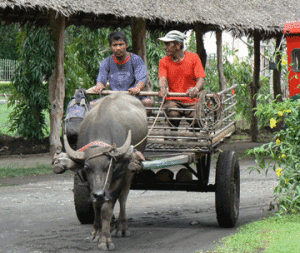Part One: Day Trips from Manila
text and photos © Scott W Clemens
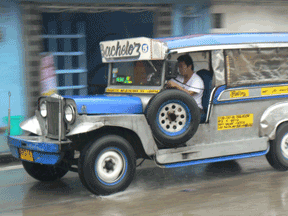 |
 |
|
Unique and whimsical Jeepneys are ubiquitous in Manila , providing cheap transportation to the masses.
|
|
A country’s cuisine reflects the various influences that have passed through its borders, and is as static or dynamic as the culture itself. The United States is a perfect example. As a “melting pot,” nation, each new wave of immigration brings with it culinary traditions that are assimilated into the culture. Some of the dishes become mainstays on the family table, other dishes become part of the cultural landscape by way of restaurants. For instance, Italian cuisine, especially as typified by various pasta dishes, has become a staple of the American kitchen, while Chinese food has become widespread and popular in restaurants, even though few non-Asians prepare it at home.
Just as America is the melting pot of cultures in the New World, the Philippines is the melting pot of the Pacific Rim. Its history is ancient — archeological evidence shows the islands have been occupied by modern humans for at least 50,000 years. Settlers came from the mainland, and traders along the Pacific Rim have continually touched at the islands for millennia. The Spanish arrived in the 16th century to lay claim to 7,101 islands that are now grouped into the nation state of the Philippines. The United States took over from the Spanish at the beginning of the 20th century, lost control briefly to the Japanese during World War II, and granted the Philippines independence in 1947. Like the U.S., it’s an amalgamation of diverse ethnic groups, religions (though Christianity predominates) and languages. The country has two official languages, Tagalog or simply Filipino (of Austronesian origins), and English. In fact, the Philippines is the 3rd most populous English speaking nation, behind the U.S. and the U.K.
As a nation of islands, the prevalence of seafood is expected, while it’s place on trade routes shows influences of from China, Japan, Southeast Asia, Spain and the United States, tempered by the availability of local fish and tropical fruits.
Philippine Airlines flys daily from both Los Angeles and San Francisco. It’s a 15 hour flight flying west, so First or Business Class is recommended if you can afford it (Business Class will cost you two and half times more). On our 747B the 32-seat Business Class was upstairs. My seat was spacious, with enormous legroom. Request a window seat — the locker between the seat and the window is big enough to store all of your carry-on gear, and it serves as a handy hassock when you’re trying to sleep. Each seat is equipped with its own video monitor with a selection of movies. The food service is excellent, starting with the beverage service, which includes Piper Heidsieck champagne, Penfolds wines and an array of spirits, beer, juices, tea, coffee, sodas etc. The dinner includes various hot and cold appetizers, a choice from three entrées (Chinese, Asian Coastal, or Filipino), fruit, Häagan-Dazs ice cream, and a cheese plate. For breakfast you have a choice of juices, fruit and yogurt, modern Chinese (on our flight, pork spareribs with abalone sauce, and poached pumpkin rice), Asian Fusion (soft-shelled crab with bacon, eggs, spinach and rice), or the Filipino Specialty (Milkfish in a garlic-lemon sauce).
Our late October flight left San Francisco at 10:30 p.m., reached Guam 11 hours later, and after an hour layover and another three hours in the air, we arrived in Manila, the capital city of the Philippines on the big island of Luzon. Having passed the dateline, we arrived at 5:30 a.m., two days after we had left San Francisco. It was the first long flight I’ve ever taken where the entire flight time was in darkness.
We arrived in a drizzle (the rainy season is June through October), and stayed at the Hyatt Hotel and Casino in downtown Manila. It’s an ultra modern hotel with 378 luxurious rooms, marble showers, deep bathtubs, and a quiet and classy casino. Rooms start at $220 USD. Catering to an international clientele, Market Café’s breakfast buffet covers all of the bases, whether you’re from Europe, the United States, China, Japan or the Philippines. The hotel’s Fireplace Steakhouse features a wood-fired oven and an 800 bottle wine cellar — we enjoyed a salad of grilled wild mushrooms with arugula and goat cheese; lobster bisque; prime rib eye of Angus beef; marinated Tiger prawns with asparagus; and a captivating hot chocolate soup with vanilla cracked pepper ice cream.
Virtually leveled in the fighting between the Americans and the Japanese at the end of World War II, Manila is a sprawling metropolis of huge contrasts, with modern skyscrapers, Ritzy condos, and surrounding shanty towns. It’s what you might expect of a population that has one foot in 21st century, and another in the 16th. Our guide told us that 60% of the population of Manila is middle to upper-middle class, while 40% live in poverty). An average person might earn $500 to $600 USD a month, with an apartment renting for $150 to $250 USD a month. For the wealthy class, a condo at The Fort runs $150 to 300,000 USD. Few people own cars, preferring instead to rely on the ubiquitous Jeepneys for transportation.
 |
| War’s marble forest: The American Cemetery and Memorial in Manila is a grim reminder of the real cost of war. The more than 17,000 buried here, and more than 36,000 listed as missing in action, fought and died in the Pacific between 1942 and 1945. |
Jeepneys, unique and often whimsical, spew diesel smoke everywhere in the Philippines. They evolved from vehicles that were originally cobbled together from war surplus jeeps that America left behind after the war. When parts became scarce in the ‘70s, two companies went into business building these vehicles of galvanized and stainless steel. Powered by Isuzu engines and looking like a cross between an old-fashioned jeep and a stretch limo, they cost about $6,000, and due to a tax loophole they’re purchased in pieces and assembled. Each Jeepney is individually decorated and bears a sign indicating the eventual destination. The back is open and 10 to 15 riders sit hunched over on facing benches. There are literally thousands of Jeepneys clogging the streets, and given the cost of gas and the level of competition, it’s hard to see how their owners can make a business of it. The appeal for their customers is the incredible bargain — the ride costs just 7 pesos (about 15 cents) for the first four kilometers, as opposed to a taxi that would cost 100 pesos per kilometer.
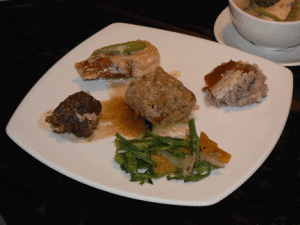 |
|
Abe restaurant serves Filipino food family style
|
Manila itself offers all sorts of dining possibilities, from American, to Chinese, to Spanish, to Mexican cuisine, but as a first time visitor I wanted to concentrate on typical Filipino food. Of the restaurants we sampled, I was most impressed by Abe (pronounced Ah bay), which means “friend, or companion.” The owner, Larry Cruz, a former journalist who has been a restaurateur for 29 years, has several restaurants around the city. His father was a writer and painter, as well as ambassador to France. The eight course meal, which cost just 850 pesos
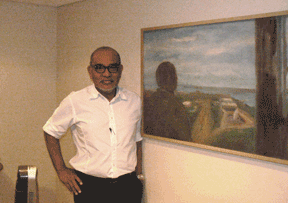 |
|
Restaurateur Larry Cruz seems reflected in a painting by his father in Abe.
|
(less than $20), consisted of tart green mango slices and garlic-pepper shrimp; a wonderful salad of diced green mango, tomato, caramelized onions and shrimp paste; large prawns in coconut sauce; pork with liver sauce; lamb with spicy garlic sauce; Milk Fish and mango soup; stewed vegetable and squash; and Banana adobo. As we were leaving, Imelda Marcos was arriving (yes, the former first lady of the Philippines, former Governor of Manila and congresswoman) — it sometimes seems like a very small world indeed.
Like any big city, you can find anything in Manila, from fine art and parks, to sleazy side streets, sordid bars and gyp-joints. I like to visit cities, but I find a country’s charm is usually found in the countryside. Unfortunately, driving in the Philippines is a hair-raising experience, and finding your way on unfamiliar roads with poor signage can be problematic. Fortunately, there are several good tour companies which can provide you with an air-conditioned vehicle and a guide for a day tour away from Manila. We used Rajah Tours, which provided a driver and a guide, and arranged for lunch on two tours we took into the countryside south of Manila. For a couple, the 8 to 9 hour
round trip tour, including lunch, is about $300 (slightly more for the spa package, which includes a massage). I can recommend two day trips out of Manila, which will make your stay in the Philippines more rewarding — first, Villa Escudero with a stop at nearby Kusina Salud for a cooking demonstration; second, a surprising lunch and a relaxing massage at The Farm at San Benito.
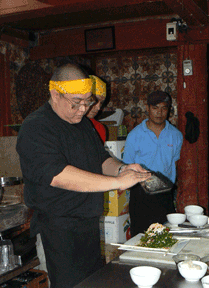 |
|
Chef Paul Poblador
|
Traveling south out of Manila on the South Luzon Expressway the traffic is heavy, the roads filled with Jeepneys and Motor tricycles (another cheap form of transportation that is ubiquitous in the Philippines). About an hour from the city the road narrows and cuts through a series of small
towns that are full of color and activity. Another half hour and you’re in a deep jungle in the Laguna district, with wild banana and mango trees. This is where I would get lost, but our driver found the tiny road that lead to Kusina Salud, where Paul Poblador serves Filipino food served in a Filipino home, prepared with technique and discipline learned at the California Culinary Academy in San Francisco. The restaurant is located in the vacation home of his mother-in-law, internationally renowned textile designer, Patis Tesoro. The grounds include a gift shop, aviary, and day spa (after your meal you why not enjoy a 45-minute facial or foot massage). Paul gave a demonstration in preparing two local dishes, Pako salad and deep fried pork belly (see sidebar), while we sipped an unusual and very tasty lemongrass iced tea.
If any dish could be considered the national dish, it would be pork adobo. Adobo, meaning marinade, is a combination of garlic, soy sauce and vinegar, and is usually used with pork, but often with chicken and other meats. However, Poblador is quick to point out that Filipino food is not just about adobo. “One of the most interesting differences between Philippine food and Indonesian and Thai, is the others mix sweet and sour in one dish,” says Poblador. “We mix sweet dishes and sour dishes on the same table.” Also, Philippine soups are sour, usually from the infusion of lemongrass. Malay, Thai and Indonesian dishes also tend to be spicier.
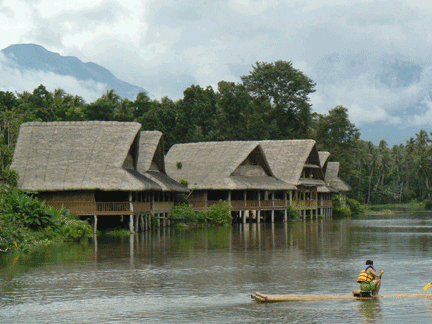 |
|
Villa Escudero coconut plantation and resort
|
From Kusina Salud we drove a short way to Villa Escudero, a working coconut plantation and resort. Overnight stays are a bargain, and include three meals. Day visitors have use of the recreational facilities (rafting on the lake, bicycling, tennis, or swimming in one of the pools), and are afforded a carabao cart ride, lunch at the restaurant and a tour of the Escudero family museum, an eclectic collection of Philippine artifacts from the Spanish era through the American era. More than 100 families live on the property, tending a sea of coconut trees. A Philippine cultural show is presented on Friday, Saturday and Sunday.
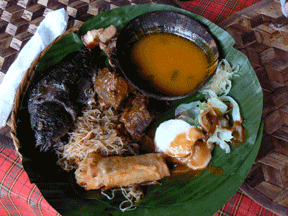 |
|
Lunch at Villa Escudero
|
Since we’re talking about Villa Escudero, it seems appropriate to note some peculiarities in Filipino pronunciation. Villa, which in Spanish is pronounced Vee-ya, is pronounced Vilea. Pollo (in Spanish Poy-yo) is pronounced Polio. You may also hear Filipino and Pilipino used interchangeably — our guide preferred the “P” pronunciation, while other Filipinos on our bus preferred the “F” pronunciation; there seemed no consensus, and perhaps it’s just a dialectical variation.
Our second day-trip was to the neighboring Batangas district, also two hours south of Manila, and a little further west. There we visited The Farm at San Benito. Surrounded by rainforest, the Farm is a very special place, dedicated to physical, mental and spiritual health. German Eckard Rempe and his Filipina wife Perla Espino bought the 120-acre property in 2002. Twenty-two acres have been developed. The beautifully landscaped grounds include a spa, a clinic with three medical doctors, a vegan restaurant, 24 villas, several meditation spots, jogging and garden paths, an organic garden and coconut trees. Everywhere you look you’ll find tropical flowers, butterflies, flowing water and fountains.
 |
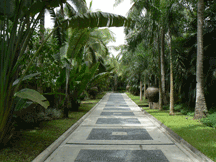 |
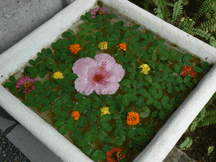 |
|
The tranquil grounds of The Farm at San Benito offer guests a chance to relax away from the noise, activity and congestion of Manila.
|
||
I have to admit to a certain prejudice against New Age terminology and claims of energy spots and spiritual vortexes, and there is a certain amount of that here. However, if you go to Manila and find yourself yearning to get away from the smog and hubbub of the city, I strongly suggest you turn south toward The Farm at San Benito. There really is something magical about the place. The frenetic pace of the city is replaced by a tranquility of spirit; the air is clean; your cares just seem to melt away. The Farm offers everything from a day visit at the spa, to a 17-day program designed to restore your health through medically supervised detoxification. Rempe would like to emphasize the health treatments over the luxury spa, and some people are listening — Spa Asia magazine recently recognized The Farm with its Crystal Award for Best in Holistic Treatment, citing The Farm’s detox program, life coaching, massages, diets and exercise programs. There are also classes in yoga and meditation.
 |
 |
 |
Our visit included a tour of the property, an incredibly relaxing reflexology massage, and lunch at Vegan restaurant. The spa is set on high ground next to a zero horizon pool overlooking the rainforest. The massages are given under a canopy next to the pool, so you can feel the breeze and hear the flowing water and tropical birdsong.
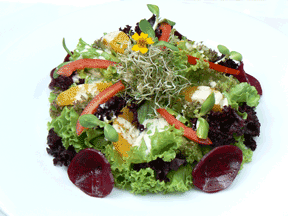 |
 Tomato tower, at the vegan restaurant at The Farm at San Benito |
|
organic salad
|
tomato tower
|
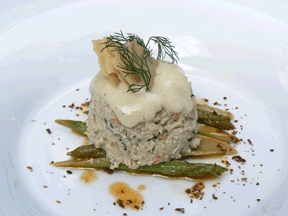 cauliflower risotto |
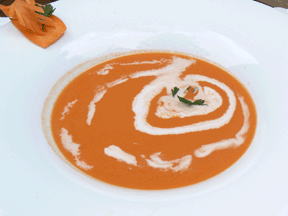 |
|
cauliflower risotto
|
carrot soup
|
When we were told the restaurant was 100% vegan and 85% of the food was raw (or cooked at less than 107 degrees F.) I heard a lot of grumbling from the group. Yet this turned out to the best tasting, most satisfying meal of our trip. Chef Napoleon Arrieta created an exquisite six-course meal from organic produce grown on the property. We began with an organic salad, followed by a tomato tower (see recipe in sidebar), carrot soup, cauliflower risotto, polenta mushroom tart, and finally a banana caramel cake. The portions were small, but filling, and no one was grumbling at the end of the meal.
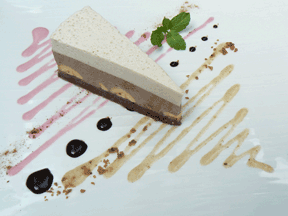 |
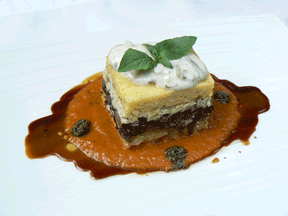 |
|
banana caramel cake
|
polenta mushroom tart
|
I was sorry to leave. The next time I go to Manila, I’ll make a point of staying at The Farm for at least two days. Imagine waking up to birdsong, eating tasty food grown on the premises, taking a book to one of the quiet meditation spots, and topping off your day with a relaxing massage. What could be better?
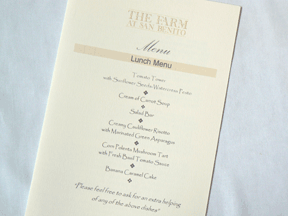 |
Kusina Salud
285 Brgy. Santa Cruz, San Pablo City, Laguna 4000
cell: +639217726985
email: kusinasalud@yahoo.com and kusinasalud@gmail.com
Villa Escudero
Manila Office: 1059 Estrada Street, Malate 1004 Metro Manila
Provincial Mailing Address: P.O. Box 4 San Pablo City 4000
Tel: 521-0830/ 523-0392/ 523-2944
Fax: 521-8698
Email: vespar@pldtdsl.net
Website: www.villaescudero.com
The Farm at San Benito
119 Brgy. Tipakan, Lipa City, Batangas
Tel: 696-3795 (Manila line)
Fax: 696-3175
Email: info@thefarm.com.ph
Website: www.thefarm.com.ph
Hyatt Hotel and Casino Manila
1588 Pedro Gil cor. M.H. Del Pilar
Malate, Manila 1004
Tel: +63 2 245 1234
Fax: +63 2 247 1234
Email: hyattmanila@hyattintl.com
Website: www.manila.casino.hyatt.com
Philippine Airlines: www.philippineairlines.com
Rajah Tours: www.rajahtoursphilippines.com
